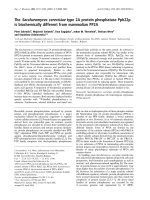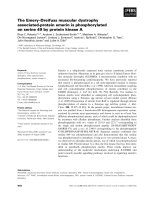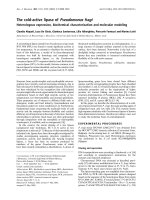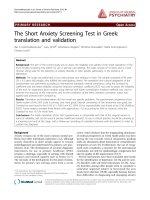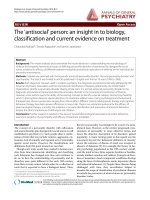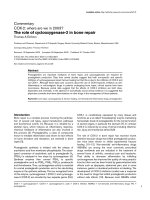Báo cáo y học: "The anti-cyclic citrullinated peptide response in tuberculosis patients is not citrulline-dependent and sensitive to treatment" ppsx
Bạn đang xem bản rút gọn của tài liệu. Xem và tải ngay bản đầy đủ của tài liệu tại đây (483.93 KB, 7 trang )
Elkayam et al. Arthritis Research & Therapy 2010, 12:R12
/>Open Access
RESEARCH ARTICLE
© 2010 Elkayam et al.; licensee BioMed Central Ltd. This is an open access article distributed under the terms of the Creative Commons
Attribution License ( which permits unrestricted use, distribution, and reproduction in
any medium, provided the original work is properly cited.
Research article
The anti-cyclic citrullinated peptide response in
tuberculosis patients is not citrulline-dependent
and sensitive to treatment
Ori Elkayam*
†1
, Refael Segal
†2
, Daniele Bendayan
3
, Robert van Uitert
4
, Carla Onnekink
5
and Ger JM Pruijn
5
Abstract
Introduction: Patients with tuberculosis (TB) frequently produce anti-citrullinated protein antibodies (ACPA). The
objective of this study is to characterize the citrulline-dependence of the ACPA reactivity in sera of patients with
mycobacterium infections.
Methods: Serum samples of 134 patients with untreated mycobacterium infections (122 TB, 12 nontuberculous
mycobacterium) were tested for antibodies against both the citrullinated (Cit) and the non-citrullinated (Arg) form of 2
cyclic synthetic peptides. In 33 patients, a follow-up sample was tested six months after starting anti-mycobacterial
drugs.
Results: A substantial proportion of patients with mycobacterial infections demonstrated antibodies against 0401Cit,
0401Arg, 0722Cit and 0722Arg. Fourteen patients demonstrated anti-0401Cit, 83 anti-0401Arg, 22 anti-0722Cit and 61
anti-0722Arg, while none of these antibodies were detected in the 20 healthy controls. All the patients but one, who
were anti-0401Cit and anti-0722Cit positive, demonstrated reactivity against the respective Arg peptide. In the subset
of 33 patients with a follow-up test six months after starting treatment, the mean levels of antibodies to 0401Cit,
0401Arg, 0722Cit and 0722Arg significantly decreased after treatment. All the patients who were anti-0401Cit and anti-
0722Cit positive turned negative after treatment. The presence of anti-0401Cit/Arg and anti-0722Cit/Arg was found to
be significantly correlated with the presence of HIV.
Conclusions: ACPA may be found in patients with TB. In most of the cases, the reactivity is citrulline independent. A
positive cyclic citrullinated peptide (CCP) test in these patients should therefore be interpreted with care, and
preferably followed by a control ELISA with a non-citrullinated antigen.
Introduction
A group of autoantibodies, anti-citrullinated protein anti-
bodies (ACPA), has been described in patients with rheu-
matoid arthritis (RA) [1]. The specificity for RA has been
shown to be up to 98% in comparison with 0 to 1% of
healthy controls and 2 to 5% of disease controls [1].
ACPA (most frequently detected by a cyclic citrullinated
peptide, CCP, test) are present early in the disease process
and may even predict the development of RA [2].
Schellekens et al. [3] and Girbal-Neuhauser et al. [4] have
shown that ACPA specifically bind to substrates contain-
ing citrulline, a post-translationally modified amino acid.
Citrullination, or peptidylarginine deimination, is the
process by which the imino group of the guanidine moi-
ety of arginine is hydrolysed, leading to the replacement
of the protonated imino group by an oxygen atom [5].
When this occurs on an arginine present in a protein, the
process is generally catalysed by a specific enzyme, the
peptidylarginine deiminase (PAD).
It has recently been reported that anti-CCP2 antibodies
can be detected in 9% of patients with type 1 autoimmune
hepatitis (AIH-1) in the absence of recognizable rheuma-
toid arthritis overlap, and in some cases with high titres,
comparable to those observed in RA [6]. However, it has
been demonstrated that a high percentage of AIH-1 sam-
* Correspondence:
†
Contributed equally
1
Department of Internal Medicine F and the Department of Rheumatology, Tel
Aviv Medical Center and The "Sackler" Faculty of Medicine, Tel Aviv University, 6
Weizman Street, Tel Aviv 64239, Israel
Elkayam et al. Arthritis Research & Therapy 2010, 12:R12
/>Page 2 of 7
ples (42 to 50%) turned out to be reactive in a citrulline-
independent manner [7].
We have reported increased levels of anti-CCP2 in up
to 32% of patients with tuberculosis (TB) [8]. These
patients also displayed increased frequency of other
autoantibodies such as rheumatoid factor (RF), antinu-
clear antibodies and others [9]. Kakumanu and collabora-
tors have recently reported that anti-CCP1 antibodies
found in TB patients often react to the unmodified argin-
ine-containing peptide as well [10].
The objective of our study was to characterize the
observed ACPA reactivities in TB, especially regarding
their dependence on the citrulline moiety, as is the case in
RA, as well as their presence after treatment. For this pur-
pose, we tested mycobacterial sera for reactivities with
citrullinated peptides as well as the corresponding argin-
ine-containing controls.
Materials and methods
Patients
One hundred and thirty-four consecutive patients with
recently diagnosed active mycobacterial infections (122
with mycobacterium tuberculosis and 12 with nontuber-
culous mycobacterium (NTM)) participated in the study.
All were admitted to the hospital department of tubercu-
losis, with clinical symptoms and radiological signs as
well as positive cultures for Mycobacterium. A question-
naire was used to determine data on the clinical features
of the disease, such as duration of symptoms, the pres-
ence of fever, cough, as well as rheumatological manifes-
tations such as arthralgia/arthritis, myalgia, rash,
mucocutaneous symptoms, sicca symptoms, spontane-
ous abortion, history of thrombosis, and familial history
of autoimmune diseases. All the patients were tested for
HIV, hepatitis B and C. Data on the resistance of the
mycobacterium was collected. Serum samples were col-
lected before starting treatment for TB or NTM infection
in all patients and six months after starting treatment
with anti-tuberculous drugs in 33 subjects. The samples
were frozen at -20°C and subsequently tested.
ELISA
Antibodies against both the citrullinated (Cit) and the
non-citrullinated (Arg) form of 2 cyclic synthetic pep-
tides (0401Cit, 0401Arg, 0722Cit and 0722Arg) were
determined by ELISA. These peptides were synthesized
with a C-terminal spacer and biotin tag. The 0401 pep-
tides consist of 18 amino acids with the Cit/Arg at the
sixth position, whereas the 0722 peptides consist of 13
amino acids with the Cit/Arg also at the sixth position.
Cyclization was achieved by coupling the side chain of a
cysteine residue at position 13 (of both peptide sets) to
the amine at the N-terminus. Streptavidin-coated pre-
blocked microtiter plates (StreptaWell, Roche-Applied-
Science, Almere, The Netherlands) were coated with 10
μg/ml peptide diluted in PBS/0.1% BSA at room tempera-
ture for one hour. The coated plates were incubated with
100 μl/well serum for one hour (200 times diluted in PBS/
1% BSA/0.05% Tween-20). This and the subsequent incu-
bation step were performed at 37°C in a humidified atmo-
sphere and were followed by washing steps with PBS/
0.05% Tween-20. Antibodies were detected after incuba-
tion for one hour with 100 μl/well rabbit-anti-human IgG
HRP-conjugated antibody (P0214, DAKO, Glostrup,
Denmark) (1:10000 in PBS/1% BSA/0.05% Tween-20).
Bound antibodies were visualized using either 100 μl/well
of 3,3',5,5'-tetramethylbenzidine (TMB) solution mixed
1:1 with urea peroxide as a substrate, followed by 100 μl/
well 2 M H
2
SO
4
10 minutes later to stop the staining reac-
tion. Optical density (OD) values were measured on an
ELISA-reader at 450 nm.
A positive control consisting of an RA serum known to
be positive for both citrullinated peptides, was included
on each plate to determine similarity between plates
coated with these peptides. Cut-off values to determine
whether a peptide was recognized or not, were defined
on the basis of the reactivity of sera from healthy control
subjects. Cut-off values for the citrullinated and arginine-
containing peptides were defined as the mean plus two
times the standard deviation of the values of 10 control
subjects, which were included on each plate.
The presence of anti-citrullinated protein antibodies in
the TB sera was also monitored using the Immunoscan
CCPlus kit (Euro-Diagnostica, Arnhem, The Nether-
lands) and the citrulline-dependency of these reactivities
was determined in parallel by ELISA using plates coated
with the corresponding arginine-containing peptides.
The study was approved by the ethics committee of the
medical center. Appropriate informed consent was
obtained from all patients, and the clinical research was
conducted in accordance with guidelines for human
experimentation specified by the Tel Aviv Sourasky Med-
ical Center.
Statistical analysis
Statistical analysis was performed by the SPSS software,
using Student's t test and the chi square test to compare
antibody titers or positivity rates, respectively, between
TB patients and controls. The Pearson correlation coeffi-
cient was used for correlations between clinical and labo-
ratory data. P < 0.05 was considered significant.
Results
Patients
Table 1 summarizes the clinical and demographic charac-
teristics of 134 patients (122 TB and 12 NTM). One hun-
dred and twenty-five patients suffered from pulmonary
involvement (almost half of them demonstrating pulmo-
Elkayam et al. Arthritis Research & Therapy 2010, 12:R12
/>Page 3 of 7
nary cavitations on chest Xray) while 19 had extrapulmo-
nary involvement. Twelve patients were HIV positive,
nine hepatitis C and five hepatitis B surface antigen posi-
tive. Thirty-two patients were born in Israel while the rest
originated from former Soviet Union (52), Africa (36) and
Asia (14).
Reactivity with citrullinated and corresponding arginine-
containing peptides
To investigate the ACPA reactivity in the sera of these TB
and NTM patients, first two pairs of synthetic peptides
were used. One of these, 0401Cit and 0401Arg, corre-
sponds to the cfc1-cyc peptide used in the first genera-
tion CCP test (CCP1) and its arginine-containing
equivalent cf0-cyc [11]; the sequence of the second pair,
0722Cit and 0722Arg, is related to a peptide used in the
second generation CCP test (CCP2), which is defined in
patent EP2071335 [12]. All of these peptides are cyclic
and, in case of the citrullinated peptides, contain a single
citrulline residue. A substantial proportion of patients
with mycobacterial infections appeared to contain anti-
bodies against 0401Cit, 0401Arg, 0722Cit and 0722Arg.
Within the group of patients with mycobacterial infec-
tions, 14 patients demonstrated anti-0401Cit, 83 anti-
0401Arg, 22 anti-0722Cit and 61 anti-0722Arg while
none of these antibodies were detected in the 20 healthy
controls (Figure 1A). All the patients but one, who were
anti-0401Cit and anti-0722Cit positive, demonstrated
reactivity against the respective Arg peptide (concor-
dance of 92% for 0401 Cit/Arg and 95% for 0722Cit/Arg).
These results indicate that the ACPA reactivities
observed in TB patients are generally not citrulline-spe-
cific. Moreover, the frequency by which the non-citrulli-
nated peptides are recognized by this patient group
appeared to be higher than that of the citrullinated pep-
tides.
The mean levels of Anti 0401 Cit/Arg and Anti 0722
Cit/Arg were significantly increased in patients with
mycobacterial infections in comparison with healthy con-
trols.
Next, ACPA reactivities in TB patient sera were deter-
mined by a commercially available CCP2 test (CCPlus).
To investigate the citrulline-dependence of the antibodies
detected by this test, the sera were analyzed in parallel
with plates coated with the same peptides in which the
citrulline residues were replaced by arginine residues
(ArgPlus). The results of these analyses confirmed that
ACPA are relatively frequently present in TB sera and
that these reactivities are not citrulline-dependent (Fig-
ure 1B).
To demonstrate that individual patient sera are reactive
with both the citrullinated and non-citrullinated pep-
tides, the results for a selection of sera (the most highly
reactive sera) are depicted in correlation diagrams in Fig-
ure 2. This indicates that most of the reactive TB sera
indeed bind to these peptides irrespective of the presence
of citrulline.
Table 1: Clinical and demographic characteristics of
patients with mycobacterial infections
No. of patients 134
Age (range) 49 ± 20
a
(17 to 99)
Gender; Male/Female (%) 69/31
Origin - (%)
Israeli 32 (24%)
Russian 52 (39%)
African 36(27%)
Asian 14 (10%)
Length of symptoms in
weeks (range)
17 ± 27
a
(1 to 100)
Atypical mycobacterium 12 (9%)
Extrapulmonary TB 19 (14%)
Miliary disease 5 (4%)
Multidrug resistance 20 (15%)
HIV positive 12 (9%)
Hepatitis C positive 9 (7%)
Hepatitis B positive 5 (4%)
a
Mean ± SD
Table 2: Levels of antibodies to citrullinated and corresponding arginine-containing peptides in 33 TB patients before and
six months after treatment
Antibodies to Baseline After treatment P
0401Cit 0.17 ± 0.13 0.10 ± 0.03 P < 0.001
0401Arg 0.23 ± 0.15 0.12 ± 0.05 P < 0.001
0722Cit 0.23 ± 0.23 0.13 ± 0.05 P < 0.001
0722Arg 0.32 ± 0.21 0.17 ± 0.06 P < 0.001
Elkayam et al. Arthritis Research & Therapy 2010, 12:R12
/>Page 4 of 7
Effect of anti-mycobacterial treatment on the reactivity
with the 0401Cit, 0401Arg, 0722Cit and 0722Arg peptides
Patients were treated with anti-tuberculous drugs to
eradicate the mycobacteria and the reactivity with the
(citrullinated) peptides was assessed six months after
starting treatment. Serum samples from 33 patients were
available for these analyses. The mean levels of antibodies
to 0401Cit, 0401Arg, 0722Cit and 0722Arg significantly
decreased after treatment (Table 2, Figure 3). Almost all
of the patients who were anti-0401Cit and anti-0722Cit
positive turned negative after treatment. Eighteen
patients who were anti-0401Arg positive and 13 who
were anti-0722Arg positive turned negative after treat-
ment. Most of the remaining patients that were reactive
with the Arg peptides before treatment (4 and 3 sera,
respectively) showed reduced levels of reactivity after
Reactivity of TB and healthy control sera with citrullinated and corresponding arginine-containing peptides
Figure 1 Reactivity of TB and healthy control sera with citrullinated and corresponding arginine-containing peptides. a) ELISA data obtained
with peptides 0401Cit, 0401Arg, 0722Cit and 0722Arg. Within the group of patients with mycobacterial infections, 14 demonstrated anti-0401Cit, 83
anti-0401Arg, 22 anti-0722Cit and 61 anti-0722Arg while none of these antibodies were detected in the 20 healthy controls. b) ELISA data obtained
with the CCPlus test and the corresponding arginine control (ArgPlus).
Table 3: Correlations between clinical data and antibodies to citrullinated and corresponding arginine-containing
peptides in patients with mycobacterial infections
Antibodies to HIV Use of
corticosteroids
Miliary TB Extra Pulmonary Africans
0401Cit R = 0.37 R = 0.45 R = 0.19 NS NS
P < 0.001 P < 0.001 P = 0.04
0401Arg R = 0.21 NS R = 0.18 R = 0.32 R = 0.25
P = 0.013 P = 0.06 P = 0.000 P = 0.006
0722Cit R = 0.41 R = 0.26 R = 0.24 R = 0.37 R = 0.24
P = 0.000 P = 0.004 P = 0.01 P < 0.001 P = 0.01
0722Arg R = 0.28 NS NS NS NS
P = 0.001
Elkayam et al. Arthritis Research & Therapy 2010, 12:R12
/>Page 5 of 7
treatment. Although the reactivity of this group of
patients with the CCPlus peptides was relatively low and,
as a consequence, not much difference was observed
before and after treatment, the recognition of the ArgPlus
peptides was also clearly diminished after treatment.
Correlation between the presence of anti-0401Cit/Arg and
anti-0722Cit/Arg and clinical characteristics of the patients
The results in Table 3 demonstrate that a significant cor-
relation was found between the presence of anti-0401Cit/
Arg and anti-0722Cit/Arg and HIV positivity (P < 0.001).
Extra-pulmonary involvement as well as African origin
Correlation between reactivities with citrullinated and with corresponding arginine-containing peptides
Figure 2 Correlation between reactivities with citrullinated and with corresponding arginine-containing peptides. The ELISA data for each
pair of peptides are depicted for the 36 most highly reactive TB sera. Values for individual sera are connected by a line.
Effect of anti-mycobacterial treatment on the reactivity with peptides 0401Cit, 0401Arg, 0722Cit, 0722Arg, CCPlus and ArgPlus
Figure 3 Effect of anti-mycobacterial treatment on the reactivity with peptides 0401Cit, 0401Arg, 0722Cit, 0722Arg, CCPlus and ArgPlus.
Comparison of the levels of antibodies against each of the peptides in sera from 33 TB patients before and after treatment.
Elkayam et al. Arthritis Research & Therapy 2010, 12:R12
/>Page 6 of 7
correlated with the presence of anti-0722Cit (P = 0.024)
(Table 3).
Factors such as age, gender, length of symptoms, persis-
tence of positive cultures, NTM, hepatitis C, hepatitis B,
multi-drug resistance TB and pulmonary cavitations did
not correlate with anti anti-0401Cit/Arg and anti-
0722Cit/Arg antibodies.
Discussion
The present study confirms our previous observation that
ACPA are relatively frequently found in the serum of
patients with mycobacterial infections. A total of 10 to
16% of patients with mycobacterial infections demon-
strated antibodies against citrullinated peptides. How-
ever, almost all of these patients also developed reactivity
against the non-citrullinated peptides. Interestingly, the
frequency by which antibodies to the non-citrullininated
peptides were detected was much higher than that of the
antibodies reactive with the citrullinated peptides. These
results strongly suggest that the antibodies produced by
TB and NTM patients are reactive with at least one
epitope in the citrullinated peptides, for which the citrul-
line residue is not critically important. Instead, the pres-
ence of an arginine at the position of the citrulline in
these peptides appeared to enhance the recognition of
this epitope by the patient antibodies.
Our results are consistent with those of Kakumanu et
al. who reported that up to 37% of TB patients developed
anti-CCP1 antibodies, while many of them reacted to the
unmodified arginine-containing peptide as well [10]. The
proportion of TB patients who were ACPA positive is
similar to our previous observation [8] and significantly
higher than in the present study. This is probably due to
the methods used in previous studies based on commer-
cial kits for ACPA detection.
Interestingly, we could show that the levels of anti-cit-
rullinated and anti-arginine-containing peptide antibod-
ies significantly decreased after anti-TB treatment. This
further supports the hypothesis that the presence of
ACPA, like other autoantibodies that have been detected
in TB patients, probably reflects a polyclonal non-specific
activation of the prolonged inflammatory process [9].
A significant correlation was found between the anti-
0401Cit/Arg and anti-0722Cit/Arg antibodies and the
presence of HIV. Humoral immunological abnormalities
are frequent in HIV and include cryoglobulins, Rheuma-
toid Factor, antinuclear antibodies, antiphospholipid
antibodies and ANCA in 17 to 51% of patients [13,14].
Because the number of HIV infected patients in our study
was limited and each of these patients was suffering from
TB, further studies are required to investigate the fre-
quency of ACPA and their specificity in patients with
HIV.
For two of the patients citrulline-specific reactivities
were observed. One of these patients, for which no after
treatment sample was available, was strongly reactive
with the 0401Cit and 0722Cit, as well as the CCPlus pep-
tides, but was not or was only very weakly reactive with
the 0401Arg, 0722Arg and ArgPlus peptides, respectively.
For the other patient, only the after treatment sample dis-
played strong reactivity with 0722Cit and CCPlus,
whereas none of the other peptides was recognized. Both
of these patients did not show signs of arthritis, but it
might be worthwhile to follow these patients to monitor
whether they will develop arthritis and whether they
remain ACPA positive.
Previously, a similar citrulline-independent ACPA
response has been reported in type 1 autoimmune hepa-
titis, AIH-1 [7]. However, in case of AIH-1 still a signifi-
cant number of patients showed citrulline-specific or
citrulline-preferred reactivities. In TB the reverse situa-
tion is observed, because these patients show arginine-
specific or arginine-preferred reactivity.
Conclusions
In conclusion, ACPA are significantly increased in
patients with untreated TB, but in contrast to RA this
response is not citrulline-dependent. The results of these
studies indicate that ACPA detection in at least a subset
of infectious and other inflammatory diseases should be
performed by using a combination of citrullinated and
the corresponding non-citrullinated antigens.
Abbreviations
ACPA: anti-citrullinated protein antibodies; AIH-1: type 1 autoimmune hepati-
tis; Arg: arginine; CCP: cyclic citrullinated peptide; Cit: citrulline; NTM: nontuber-
culous mycobacterium; PAD: peptidylarginine deiminase; RA: rheumatoid
arthritis; RF: rheumatoid factor; TB: tuberculosis.
Competing interests
The authors declare that they have no competing interests.
Authors' contributions
OE was responsible for initiative, writing of the protocol and Helsinki approval,
statistical analysis and writing of the manuscript. RS and DB recruited patients
and sera. RvU was responsible for anti-CCP2 and corresponding arginine con-
trol peptide analyses. CO gave technical assistance for ELISA analyses. GP
supervised the study, interpreted data, and wrote the manuscript.
Author Details
1
Department of Internal Medicine F and the Department of Rheumatology, Tel
Aviv Medical Center and The "Sackler" Faculty of Medicine, Tel Aviv University, 6
Weizman Street, Tel Aviv 64239, Israel,
2
Department of Geriatrics, Shmuel-Harofeh Geriatric Medical Centre and the
"Sackler" Faculty of Medicine, University of Tel Aviv, POB 2, Beer Yaakov 70300,
Israel,
3
Department of Tuberculosis, Shmuel-Harofeh Geriatric Medical Center and
the "Sackler" Faculty of Medicine, University of Tel Aviv, POB 2, Beer Yaakov
70300, Israel,
4
Euro-Diagnostica AB, Beijerinckweg 18, NL-6827 BN, Arnhem, The Netherlands
and
5
Department of Biomolecular Chemistry, Nijmegen Center for Molecular Life
Sciences, Institute for Molecules and Materials, Radboud University Nijmegen,
NL-6500 HB Nijmegen, The Netherlands
Elkayam et al. Arthritis Research & Therapy 2010, 12:R12
/>Page 7 of 7
References
1. Van Venrooij WJ, Hazes JMW, Visser H: Anti-citrullinated protein/peptide
antibody and its role in the diagnosis and prognosis of early
rheumatoid arthritis. Neth J Med 2002, 60:383-388.
2. van Gaalen FA, Linn-Rasker SP, van Venrooij WJ, de Jong BA, Breedveld FC,
Verweij CL, Toes RE, Huizinga TW: Autoantibodies to cyclic citrullinated
peptides predict progression to rheumatoid arthritis in patients with
undifferentiated arthritis: a prospective cohort study. Arthritis Rheum
2004, 50:709-715.
3. Schellekens GA, de Jong BA, Hoogen FH van den, Putte LB van de, van
Venrooij WJ: Citrulline is an essential constituent of antigenic
determinants recognized by rheumatoid arthritis-specific
autoantibodies. J Clin Invest 1998, 101:273-281.
4. Girbal-Neuhauser E, Durieux JJ, Arnaud M, Dalbon P, Sebbag M, Vincent C,
Simon M, Senshu T, Masson-Bessière C, Jolivet-Reynaud C, Jolivet M, Serre
G: The epitopes targeted by the rheumatoid arthritis-associated
antifilaggrin autoantibodies are posttranslationally generated on
various sites of [pro]filaggrin by deimination of arginine residues. J
Immunol 1999, 162:585-594.
5. van Venrooij WJ, Pruijn GJ: Citrullination: a small change for a protein
with great consequences for rheumatoid arthritis. Arthritis Res 2000,
2:249-251.
6. Fusconi M, Vannini A, Dall'aglio AC, Pappas G, Cassani F, Ballardini G,
Frisoni M, Grassi A, Bianchi FB, Zauli D: Anti-cyclic citrullinated peptide
antibodies in type 1 autoimmune hepatitis. Aliment Pharmacol Ther
2005, 22:951-955.
7. Vannini A, Cheung K, Fusconi M, Stammen-Vogelzangs J, Drenth JP,
Dall'Aglio AC, Bianchi FB, Bakker-Jonges LE, van Venrooij WJ, Pruijn GJ,
Zendman AJ: Anti-cyclic citrullinated peptide positivity in non-
rheumatoid arthritis disease samples: citrulline-dependent or not?
Ann Rheum Dis 2007, 66:511-516. Epub 2006 Sep 19.8.Elkayam O, Segal R,
Lidgi M, Caspi D: Positive anti-cyclic citrullinated proteins and
rheumatoid factor during active lung tuberculosis. Ann Rheum Dis
2006, 65:1110-1112. Epub 2005 Dec 16.9.Elkayam O, Caspi D, Lidgi M,
Segal R: Auto-antibody profiles in patients with active pulmonary
tuberculosis. Int J Tuberc Lung Dis 2007, 11:306-310.
10. Kakumanu P, Yamagata H, Sobel ES, Reeves WH, Chan EK, Satoh M:
Patients with pulmonary tuberculosis are frequently positive for anti-
cyclic citrullinated peptide antibodies, but their sera also react with
unmodified arginine-containing peptide. Arthritis Rheum 2008,
58:1576-1581.
11. Schellekens GA, Visser H, de Jong BA, Hoogen FH van den, Hazes JM,
Breedveld FC, van Venrooij WJ: The diagnostic properties of rheumatoid
arthritis antibodies recognizing a cyclic citrullinated peptide. Arthritis
Rheum 2000, 43:155-163.
12. esp@cenet [ />13. Bonnet F, Pineau JJ, Taupin JL, Feyler A, Bonarek M, de Witte S, Bernard N,
Lacoste D, Morlat P, Bevlot J: Prevalence of cryoglobulinemia and
serological markers of autoimmunity in human immunodeficiency
virus infected individuals: a cross-sectional study of 97 patients. J
Rheumatol 2003, 30:2005-2010.
14. Sène D, Piette JC, Cacoub P: Antiphospholipid antibodies,
antiphospholipid syndrome and infections. Autoimmun Rev 2008,
7:272-277.
doi: 10.1186/ar2913
Cite this article as: Elkayam et al., The anti-cyclic citrullinated peptide
response in tuberculosis patients is not citrulline-dependent and sensitive to
treatment Arthritis Research & Therapy 2010, 12:R12
Received: 23 July 2009 Revisions Requested: 12 August 2009
Revised: 24 November 2009 Accepted: 25 January 2010 Published: 25
January 2010
This article is available from: 2010 Elkayam et al.; licensee BioMed Cen tral Ltd. This is an open access article distribute d under the terms of the Creative Commons Attribution License ( which permits unrestricted use, distribution, and reproduction in any medium, provided the original work isproperly cited.Arthritis Research & Therapy 2010, 12:R12
